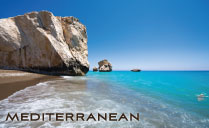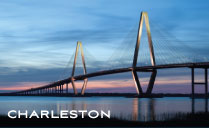Paradise Found by Captain John Borden
The Grenadines: Islands in the Clouds Part IV: Palm Island and Petite St. Vincent
13.15°N.Lat./61.2°W.Lon.
 Located at the southern end of the archipelago belonging to St. Vincent and the Grenadines lie two resort islands quite different in character from one another or from anywhere else in the Caribbean. Palm Island and Petite St. Vincent are both privately owned and operated by expatriated Americans who made their dreams of owning an island paradise a reality.
Located at the southern end of the archipelago belonging to St. Vincent and the Grenadines lie two resort islands quite different in character from one another or from anywhere else in the Caribbean. Palm Island and Petite St. Vincent are both privately owned and operated by expatriated Americans who made their dreams of owning an island paradise a reality.
John Caldwell is the Caribbean’s answer to Johnny Appleseed. He not only resurrected his lush Palm Island resort from a scrubby mosquito haven, Caldwell also did a great deal to improve the scenic condition of quite a few Grenadine Islands-simply by planting an abundance of coconut palms almost everywhere he sailed. His life story is loosely documented in a biography entitled Desperate Voyage. The first edition, bearing a different title, was primarily a romantic account of Caldwell’s sailing voyage to Australia to reclaim the Aussie mate he fell in love with while serving on a navy ship in the South Pacific. His publisher, however, was not impressed, insisting there wasn’t enough perilous conflict for a sea adventure. Needless to say, John Caldwell’s second draft was packed with enough embellishment to make an experienced sailor cringe, and his fastidious publisher smile. Compared to fighting off sharks and monsoons, Palm Island was a welcome change.
Only half a mile in diameter, Palm Island is as laid back as you can get. The simple palm-thatched bungalows and open air bar are handsomely set in front of Casarina Beach, which may well be the most beautiful stretch of sand in the Grenadines. Sailors approaching the island from the north first notice two large solar panels occupying a large part of the island’s only hill. These collectors not only serve as a convenient land bearing, they also make sure the island’s energy needs are quietly fulfilled. All visiting yachtsmen should make it a point to anchor on the southwest side facing the resort and go ashore for a drink and perhaps lunch. Just one mile west of the bar is a spectacular view of the Union Island skyline. The jagged mountains of Union are very impressive, resembling a setting more likely found in the South Pacific.
 Union is the hub of the southern Grenadines with an airstrip, local hotels, restaurants and, most importantly, the customs and immigration office. American and European sailors coming and going can make Union’s tiny Clifton port seem almost cosmopolitan. There’s plenty of local color as well. For example, one rather interesting waterfront diner is constructed entirely of conch shells and mortar. Three guesses what the specialty of the house is!
Union is the hub of the southern Grenadines with an airstrip, local hotels, restaurants and, most importantly, the customs and immigration office. American and European sailors coming and going can make Union’s tiny Clifton port seem almost cosmopolitan. There’s plenty of local color as well. For example, one rather interesting waterfront diner is constructed entirely of conch shells and mortar. Three guesses what the specialty of the house is!
While several commercial flights arrive daily in Clifton Bay, I would advise the meek at heart to come by boat. To touch down on the Union Island runway, a pilot must execute a hair-raising nose dive down a mountain face, only to pull up to an abrupt stop before sliding off into the Caribbean Sea. A friend of mine who is rather proud of his aeronautical skills took three passes before attempting to land. Flying a large kite off the stern of my charter yacht seemed a clever way to signal our whereabouts to him. When we later met at the bar (he was in dire need of a drink by then), I asked why he hesitated in his landing. Exasperated, he exclaimed, “I would have made it on my first try had I not been so distracted by some damn kite!”
At times it appears everyone in Clifton is engaged in some sort of sporting activity, from street soccer to a vocal game of dominoes. Even basketball is given an island twist: the leathery feet of local players are rarely clad at all, much less with the overpriced footwear kids fight over in the states. I was surprised to find one of the kids I played with, Adonal Foyle, later playing in the NBA. This lanky, seven-foot sixteen-year-old was head and shoulders above his peers. I was pleased to read in Sports Illustrated that he was using basketball simply as a means to further his education. (Adonal claims the sport, as played in the U.S., calls for ferocity not befitting a future prime minister of St. Vincent and the Grenadines.)
It was also in Clifton Bay during the local May Day Festival that I first met John Caldwell. I had no idea who he was, other than a barefoot, bare-chested old fellow wearing a curious palm frond hat. He was actively gathering everyone within arm’s reach to participate in a friendly tug-of-war. I’ve heard John has a tendency to coerce his resort guests in much the same way for a morning jog and swim.
 A couple of miles southeast of Union and Palm is the much more formal island resort of Petite St. Vincent. Like John Caldwell, its founder, Haze Richardson, had also taken to sailing shortly after serving his country. Of course he fell in love with the Grenadines and ultimately with the prospect of building an exclusive, first class island resort. Forty years ago, his idea was that, once established, he could install efficient management to run the resort, enabling him to come and go as he pleased. Today, the manager is still Haze Richardson and, to my knowledge, in all these years he has rarely had a vacation. I wouldn’t feel too sorry for him though. PSV is a beautiful and popular island retreat. Each private stone cottage is equipped with a flag pole to summon room service. Needless to say, Richardson knows how to pamper his guests. PSV also accepts a limited number of visiting yachtsmen for lunch and dinner. I suggest you radio ahead and reserve a table in the Overlook, where the view is as fantastic as the food.
A couple of miles southeast of Union and Palm is the much more formal island resort of Petite St. Vincent. Like John Caldwell, its founder, Haze Richardson, had also taken to sailing shortly after serving his country. Of course he fell in love with the Grenadines and ultimately with the prospect of building an exclusive, first class island resort. Forty years ago, his idea was that, once established, he could install efficient management to run the resort, enabling him to come and go as he pleased. Today, the manager is still Haze Richardson and, to my knowledge, in all these years he has rarely had a vacation. I wouldn’t feel too sorry for him though. PSV is a beautiful and popular island retreat. Each private stone cottage is equipped with a flag pole to summon room service. Needless to say, Richardson knows how to pamper his guests. PSV also accepts a limited number of visiting yachtsmen for lunch and dinner. I suggest you radio ahead and reserve a table in the Overlook, where the view is as fantastic as the food.
Just to the north of Petite St. Vincent are two picturesque sand-spit islands, Pinese and Mopion. Mopion, the larger of the two, even has a thatch shelter affording visitors a refuge from the Caribbean sun. Snorkeling around Mopion is exceptional. I have spent an entire day here with charter guests who inevitably wonder whatever happened to the time.
Since settling in Charleston and starting a family, my wife Carole and I often wonder the same thing. I believe it was Fitzgerald who wrote, [We are all alike] “boats against the current, borne back ceaselessly into the past.” In the end it is not so much the things we cherish as the people and places that fill our lives. Of all my time spent sailing the southern trades of the eastern Caribbean it is in these “islands in the clouds” where I am “borne back” most often. However, one should never linger too long on any given subject. So, if you would like to know more about these people and places of the Grenadines you will simply have to go there yourself. You will find the journey well worth it!





